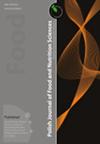Kefir通过诱导高果糖玉米糖浆喂养大鼠的凋亡元素抑制脂肪组织生长
IF 2.3
4区 农林科学
Q3 FOOD SCIENCE & TECHNOLOGY
引用次数: 0
摘要
饮食中摄入高果糖玉米糖浆是导致腹部肥胖的一个原因;然而,这种关联背后的分子机制仍有待商榷。本研究评估了HFCS对脂肪组织造成的代谢紊乱,以及开菲尔作为预防这些代谢紊乱的疗法的可能性。雄性Wistar大鼠分为四组:对照组、开菲尔组、HFCS组和HFCS+kefir组。HFCS(20%,w/v)在饮用水中和开菲尔(1mL/100g体重)中通过每天胃灌胃给予,持续8周。用蛋白质印迹和免疫组织化学技术测定脂肪组织的胰岛素信号传导、炎症和凋亡相关蛋白的水平。用半定量实时聚合酶链反应(qRT-PCR)评估基因表达。间接末端脱氧核苷酸转移酶dUTP缺口末端标记(TUNEL)法用于评估凋亡细胞的变化,苏木精/伊红染色用于确定脂肪细胞的数量和直径。因此,HFCS增强了蛋白激酶B(Akt)和p-Akt,同时降低了核因子κB(NF-κB)和肿瘤坏死因子α(TNFα)的水平,尽管提高了NF-κB和TNFα,但凯菲尔治疗恢复了HFCS治疗大鼠的Akt诱导。Akt和B细胞淋巴瘤-2基因(Bcl2)表达的增加与Nfkb、Tnfa、肿瘤蛋白53基因(p53)和胱天蛋白酶-8基因(Casp8)表达的减少形成对比。此外,虽然HFCS组中TUNEL阳性细胞显著减少,但HFCS+kefir组中此类细胞的数量更多。这些结果表明,摄入HFCS会抑制脂肪组织中的细胞凋亡,这可能是组织发育和腹部肥胖的原因,并且由于细胞凋亡相关基因和蛋白质的激活,服用开菲尔可能会逆转细胞凋亡。本文章由计算机程序翻译,如有差异,请以英文原文为准。
Kefir Prevents Adipose Tissue Growth Through the Induction of Apoptotic Elements in High-Fructose Corn Syrup-Fed Rats
Consumption of high-fructose corn syrup (HFCS) in the diet is a causal factor in the development of abdominal obesity; however, the molecular mechanism behind this association is still up for debate. This study evaluated the metabolic disturbances that are caused by HFCS on adipose tissue as well as the possibility of kefir as a therapy to prevent these metabolic disturbances. Male Wistar rats were divided into four groups: control, kefir, HFCS, and HFCS+kefir. HFCS (20%, w/v ) was given in drinking water and kefir (1 mL/100 g body weight) by gastric gavage daily for 8 weeks. Levels of insulin signaling, inflammation, and apoptosis-associated proteins of adipose tissues were determined with Western blot and immunohistochemical techniques. Gene expressions were evaluated with semi-quantitative real-time polymerase chain reaction (qRT-PCR). The indirect terminal deoxynucleotidyl transferase dUTP nick-end labeling (TUNEL) method was used to assess changes in apoptotic cells, and hematoxylin/eosin staining to determine adipocyte number and diameter. Accordingly, HFCS boosted protein kinase B (Akt) and p-Akt while reducing nuclear factor κB (NF-κB), and tumor necrosis factor alpha (TNFα) levels and kefir treatment restored Akt induction in HFCS-treated rats despite raising NF-κB, and TNFα. Increased expression of Akt and B-cell lymphoma-2 gene ( Bcl2 ) was contrasted with decreased expression of Nfkb, Tnfa, tumor protein 53 gene ( p53 ), and caspase-8 gene ( Casp8 ). Furthermore, while there was a marked reduction in TUNEL-positive cells in the HFCS group, the number of such cells was greater in the HFCS+kefir group. These results show that HFCS intake suppresses apoptosis in adipose tissues, which may be responsible for tissue development and abdominal obesity and may be reversed with kefir administration due to the activation of apoptosis-associated genes and proteins.
求助全文
通过发布文献求助,成功后即可免费获取论文全文。
去求助
来源期刊

Polish Journal of Food and Nutrition Sciences
FOOD SCIENCE & TECHNOLOGY-
CiteScore
4.30
自引率
12.50%
发文量
25
审稿时长
20 weeks
期刊介绍:
The Polish Journal of Food and Nutrition Sciences publishes original, basic and applied papers, reviews and short communications on fundamental and applied food research in the following Sections:
-Food Technology:
Innovative technology of food development including biotechnological and microbiological aspects
Effects of processing on food composition and nutritional value
-Food Chemistry:
Bioactive constituents of foods
Chemistry relating to major and minor components of food
Analytical methods
-Food Quality and Functionality:
Sensory methodologies
Functional properties of food
Food physics
Quality, storage and safety of food
-Nutritional Research Section:
Nutritional studies relating to major and minor components of food (excluding works related to questionnaire
surveys)
-“News” section:
Announcements of congresses
Miscellanea
 求助内容:
求助内容: 应助结果提醒方式:
应助结果提醒方式:


